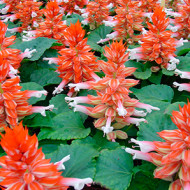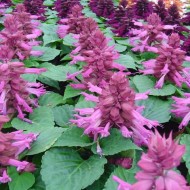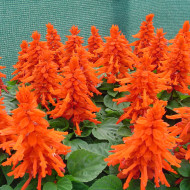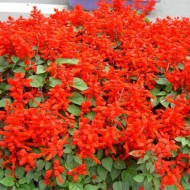Features of planting and growing brilliant salvia in the open field
Content
Description of salvia brilliant
Sage (salvia or sylvia) was known to the ancient Romans. However, the Old and New World began to grow this plant only in the 18th century. A highly decorative shrub with many colors belongs to the Lamiaceae family. As a rule, it is a one- or two-year-old plant with a height of 25–80 cm, with a powerful root system.

Erect tetrahedral stems are densely covered with elongated whole leaves on long petioles. The upper part of the leaf plate has a dark green color, and the lower one casts a silvery tint.
From mid-summer to late autumn, salvia produces lush spike-shaped inflorescences up to 20 cm long, consisting of 30–90 small tubular flowers. Later, sage develops dark brown fruits in the form of nuts from four lobes.
Common varieties
Sage has more than 900 varieties that grow almost all over the planet. Below we provide a description of the most popular sparkling salvia varieties.
- Dwarf
- Splendis pink
- Rio
- Carabiner
- Bonfire
Fire ball
Low-growing sage no more than 0.5 m in size. It grows in compact bushes with a diameter of 30–40 cm. Spike-shaped inflorescences occupy a third of the stem length, are painted in a bright fiery shade with a coral tint.
Vesuvius
Belongs to varieties, the height of which does not exceed 50 cm. The leaves are large, up to 10 cm long and 9 cm wide. Starting from the first decade of August, the plant is covered with dense ears of rich scarlet color.
Bonfire
Sparkling salvia in a bright coral shade with dense buds. An annual shrub grows up to 0.6 m, forming compact bushes with a diameter of 45–55 cm. Sage retains high decorative qualities from mid-summer to late autumn.
Carabiner
A low-growing plant, only 30 cm high. Due to its small size, it can be planted with a minimum distance between bushes. From July until the first frost, salvia is covered with bright red-orange ears.
Zurich
A tall variety ranging in size from 60 to 70 cm. It belongs to varieties with a late flowering period. The length of large inflorescences of a juicy red-coral shade is almost half the length of the stem.
Scarlet
Low-growing salvia, no more than 30 cm in height. Lush diamond-shaped inflorescences are painted in a dark scarlet shade. The leaves are large, bright green. Scarlet retains its decorative qualities from mid-summer to late autumn.
Rio
The size of the shrub ranges from 25 to 30 cm. The spike-shaped short inflorescences, as well as the stem of the Rio sage itself, have a rich lilac hue. The leaf plates are highly elongated, with pointed edges.
Splendis pink
A low-growing variety with a height of 0.3 m with large dark green leaves.During the flowering period, which begins in the second decade of July and ends with the first frost, the shrub is covered with dense purple-lilac ears.
Charm pink
Brilliant salvia of bright pink color, no more than 0.3 m in size. The variety has a reverse pyramidal shape. Compact bushes bloom in mid-July, continuing to maintain decorative qualities until late autumn.
Horminum
Low-growing frost-hardy sage 0.5 m high. Compact shrub from July until the first frost covered with multi-colored ears. The plant can combine white, blue, lilac or pink shades.
Dwarf
A miniature variety, the size of which does not exceed 25 cm. It has an unusual variegated color. The dense, spike-shaped inflorescences of the sparkling Dwarf Salvia are colored scarlet with white streaks.
Video "Salvia is brilliant in nature and in the country"
This video tells about the features of growing a highly decorative shrub.
Cultivation of cultivated sage
Flower lovers love sage for its simplicity and minimal maintenance requirements. The plant is able to adapt to any climatic conditions without losing its decorative effect.

Sowing dates in 2019 according to the lunar calendar
In order for brilliant salvia to grow well, bloom profusely and get sick less, flower growers recommend using the lunar calendar when growing it. Favorable dates for sowing planting material in 2019 will be:
- 6, 7, 8, 11, 12, 13, 14, 15, 16, 17, 21, 22, 23, 24, 25 February;
- March 12, 13, 14, 15, 16, 17, 19, 20;
- April 6, 7, 8, 11, 12, 13, 15, 16, 17, 29, 30.
It is better to transplant young seedlings into open ground:
- May 8, 9, 10, 11, 12, 13, 14, 15, 16, 17, 21, 22, 23, 26, 27, 28;
- June 1, 2, 5, 6, 9, 10, 11, 12, 13, 20, 21, 22, 23, 24, 25, 26.
You should not plant sage on the following days:
- February 4, 5, 19;
- 6, 7, 21 March;
- April 5, 19;
- May 5, 19;
- June 3, 4, 17.
Preparing the soil for sowing
The soil for growing salvia should be with good permeability, lightweight, nutritious. The plant will feel comfortable in the soil mixture, where, in addition to ordinary soil, peat and humus are present. In this case, the acidity should be maintained at a pH level of 5.5–6.5.
Sowing seeds
Sowing seedlings is carried out from February to March. Salvia seeds are mixed with sand and spread in a thin layer on the soil surface. Containers with planting material are covered with glass or polyethylene, forming a kind of greenhouse. At a temperature of + 22 ... + 25 ° С, the first sprouts are waiting. Then the film is removed, exposing the seedlings to the sun's rays.
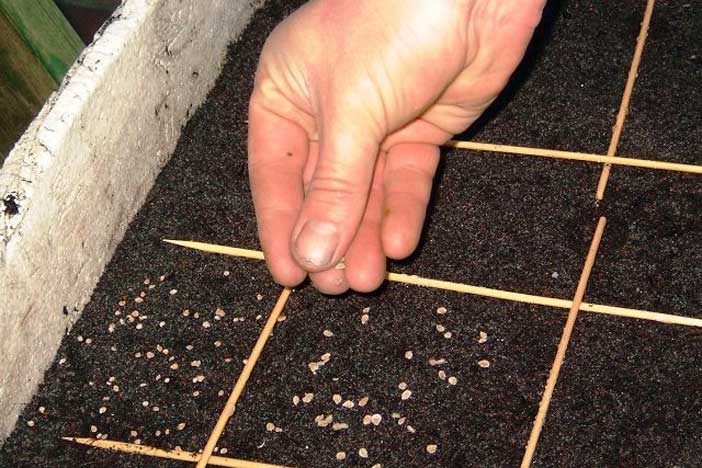
Regular watering of young seedlings is best done with a spray bottle to protect the plant from waterlogging. The pick is made after the appearance of the first 2-3 leaves. After seating each specimen in separate containers, after 10-14 days the salvia is fed for the first time.
Landing in open ground
Ornamental sage should be transplanted into flower beds starting from the first days of May. The soil for planting is loosened, fertilized, a small amount of lime, humus, sand is introduced. Seedlings are gradually hardened 14 days before planting.
Sparkling salvia is best planted in sunny areas of the garden. The planting holes are dug at intervals of at least 20 cm. A drainage layer of expanded clay is laid on the bottom. Having placed the seedling in the hole, it is sprinkled with soil mixture with the addition of wood ash and mineral fertilizers.
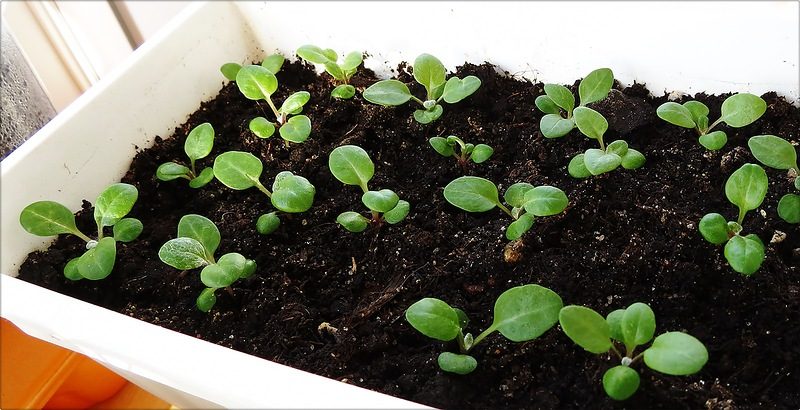
Watering and feeding
Although salvia is a moisture-loving plant, it is often not worth watering the flowers. Regular hydration is only necessary until the budding period.Further, sage can do without irrigation at all. Thus, it will form into a compact, abundantly flowering bush with a bright color.
You need to fertilize the shrub throughout the season. During the formation of shoots, organic nitrogen fertilizers are used. When laying buds and flowering, potassium-phosphorus compounds are introduced. Feeding with complex preparations is carried out every 2-3 weeks.
Pruning
To give the ornamental shrub the desired shape, as well as to stimulate flowering, it must be periodically pruned. Timely removal of shoots will promote active growth of sage. At the same time, the stems will no longer stretch upward, expanding only in breadth.
Final pruning is carried out before wintering. It consists in removing faded ears and woody twigs.

Post-flowering care
Often for the winter, salvia is left in a flower bed. Cut bushes are mulched with compost and covered with dry leaves or spruce branches. Thus, the plant will tolerate the winter well, without freezing even in severe frosts. However, some growers dig up sage by keeping the rhizome in a dark, dry place until warmth.
Breeding features
In addition to the seed method, sparkling salvia can be bred by cuttings. The process consists of the following steps:
- twigs 10-15 cm long are split off from an adult flower;
- the cuttings are dipped in water and left for 1.5–2 weeks;
- withered leaves are regularly cut off;
- after the shoot gives 2 cm roots, it is transplanted into open ground.
There is also another, less popular breeding method - dividing the bush. The donor plant is dug up, the rhizomes are carefully separated and planted in a new place.
Some growers practice breeding by branches. The green shoot of salvia, without separating it from the bush, is partially buried in earth. When it has formed its own root system, the process is cut off and transplanted separately.
Since salvia is a sparkling, easily pollinated plant, it is best not to plant different varieties close to each other.
Pests and diseases of salvia brilliant
Ornamental sage is highly resistant to many fungal diseases. Occasionally, it can suffer from downy mildew, blackleg, or rot. To eliminate the infection, it is enough to treat the shrub with a special fungicide.
Most often, salvia is attacked by insect pests:
- aphid;
- whitefly;
- ticks;
- thrips.

Treatment with insecticides will help to cope with them. But you can get rid of slugs and snails only mechanically, collecting parasites by hand.
Unlike other species of the sage genus, brilliant salvia does not have medicinal properties. However, thanks to its bright aesthetics, it serves as an adornment for any garden or suburban area.

